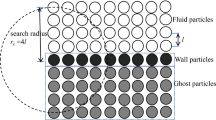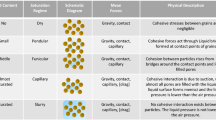Abstract
We present a Lagrangian formulation for simulating the continuum hydrodynamics of dry granular flows based on multiplicative elastoplasticity theory for finite deformation calculations. The formulation is implemented within the smoothed particle hydrodynamics (SPH) method along with a variant of the usual dynamic boundary condition. Three benchmark simulations on dry sands are presented to validate the model: (a) a set of plane strain collapse tests, (b) a set of 3D collapse tests, and (c) a plane strain simulation of the impact force generated by granular flow on a rigid wall. Comparison with experimental results suggests that the formulation is sufficiently robust and accurate to model the continuum hydrodynamics of dry granular flows in a laboratory setting. Results of the simulations suggest the potential of the formulation for modeling more complex, field-scale scenarios characterized by more elaborate geometry and multi-physical processes. To the authors’ knowledge, this is the first time the multiplicative plasticity approach has been applied to granular flows in the context of the SPH method.












After Moriguchi et al. [34]



Similar content being viewed by others
References
Adami S, Hu XY, Adams NA (2012) A generalized wall boundary condition for smoothed particle hydrodynamics. J Comput Phys 231:7057–7075
Bandara S, Ferrari A, Laloui L (2016) Modelling landslides in unsaturated slopes subjected to rainfall infiltration using material point method. Int J Numer Anal Methods Geomech 40(9):1358–1380
Becker PA, Idelsohn SR (2016) A multiresolution strategy for solving landslides using the particle finite element method. Acta Geotech 11:643–657
Bonet J, Lok TSL (1999) Variational and momentum preservation aspects of smooth particle hydrodynamic formulations. Comput Methods Appl Mech Eng 180:97–115
Borja RI (2013) Plasticity modeling & computation. Springer, Berlin
Borja RI, White JA (2010) Continuum deformation and stability analyses of a steep hillside slope under rainfall infiltration. Acta Geotech 5(1):1–14
Borja RI, Liu X, White JA (2012) Multiphysics hillslope processes triggering landslides. Acta Geotech 7(4):261–269
Borja RI, White JA, Liu X, Wu W (2012) Factor of safety in a partially saturated slope inferred from hydro-mechanical continuum modeling. Int J Numer Anal Methods Geomech 38(2):236–248
Bui HH, Fukugawa R (2013) An improved SPH method for saturated soils and its application to investigate the mechanisms of embankment failure: case of hydrostatic pore-water pressure. Int J Numer Anal Methods Geomech 37:31–50
Bui HH, Sako K, Fukugawa R (2007) Numerical simulation of soil-water interaction using smoothed particle hydrodynamics (SPH) method. J Terrramech 44:339–346
Bui HH, Fukugawa R, Sako K, Ohno S (2008) Lagrangian meshfree particles method (SPH) for large deformation and failure flows of geomaterial using elastic–plastic soil constitutive model. Int J Numer Anal Methods Geomech 32:1537–1570
Bui HH, Fukugawa R, Sako K, Wells C (2011) Slope stability analysis and discontinuous slope failure simulation by elasto-plastic smoothed particle hydrodynamics (SPH). Géotechnique 361(7):565–574
Calvetti F, di Prisco CG, Vairaktaris E (2017) DEM assessment of impact forces of dry granular masses on rigid barriers. Acta Geotech 12:129–144
Camargo J, Quadros Velloso R, Vargas EA Jr (2016) Numerical limit analysis of three-dimensional slope stability problems in catchment areas. Acta Geotech 11(6):1369–1383
Cen D, Huang D, Ren F (2017) Shear deformation and strength of the interphase between the soilrock mixture and the benched bedrock slope surface. Acta Geotech 12:391–413
Chen W, Qiu T (2011) Numerical simulations of granular materials using smoothed particle hydrodynamics method. Geotech Spec Publ ASCE 217:157–164
Chen JS, Pan C, Wu CT, Liu WK (1996) Reproducing kernel particle methods for large deformation analysis of non-linear structures. Comput Methods Appl Mech Eng 139(1–4):195–227
Dehnen W, Aly H (2012) Improving convergence in smoothed particle hydrodynamics simulations without pairing instability. Mon Not R Astron Soc 425:1068–1082
Fern EJ, Soga K (2015) The role of constitutive models in MPM simulations of granular column collapses. Acta Geotech 11(3):659–678
Gholami Khorzani M, Galindo-Torres SA, Scheuermann A, Williams DJ (2017) SPH approach for simulating hydro-mechanical processes with large deformations and variable permeabilities. Acta Geotech. https://doi.org/10.1007/s11440-017-0610-9
Gingold RA, Monaghan JJ (1977) Smoothed particle hydrodynamics: theory and application to non-spherical stars. Mon Not R Astron Soc 181:375–389
Gray JP, Monaghan JJ, Swift RP (2001) SPH elastic dynamics. Comput Methods Appl Mech Eng 190:6641–6662
Guo X, Peng C, Wu W, Wang Y (2016) A hypoplastic constitutive model for debris materials. Acta Geotech 11:1217–1229
He X, Liang D (2015) Study of the runout of granular columns with SPH methods. Int J Offshore Polar Eng 25(4):281–287
Kakogiannou E, Sanavia L, Nicot F, Darve F, Schrefler BA (2016) A porous media finite element approach for soil instability including the second-order work criterion. Acta Geotech 11(4):805–825
Lai X, Ren B, Fan H, Li S, Wu CT, Regueiro RA, Liu L (2015) Peridynamics simulations of geomaterial fragmentation by impulse loads. Int J Numer Anal Methods Geomech 39(12):1304–1330
Lee EH (1969) Elastic–plastic deformation at finite strains. J Appl Mech 36:1–6
Lei X, Yang Z, He S, Liu E, Wong H, Li X (2017) Numerical investigation of rainfall-induced fines migration and its influences on slope stability. Acta Geotech 12(6):1431–1446
Liu GR, Liu MB (2003) Smoothed particle hydrodynamics: a meshfree particle methods. World Scientific, Singapore
Lube G, Huppert HE, Stephen R, Sparks J, Hallworth MA (2004) Axisymmetric collapses of granular columns. J Fluid Mech 508:175–199
Lube G, Huppert HE, Stephen R, Sparks J, Freundt A (2005) Collapses of two-dimensional granular columns. Phys Rev E 72(4):041301
Lucy LB (1977) A numerical approach to the testing of the fission hypothesis. Astron J 82(12):1013–1024
Meng X, Wang Y, Wang C, Fischer J-T (2017) Modeling of unsaturated granular flows by a two-layer approach. Acta Geotech 12(3):677–701
Moriguchi S, Borja RI, Yashima A, Sawada K (2009) Estimating the impact force generated by granular flow on a rigid obstruction. Acta Geotech 4:57–71
Nguyen CT, Nguyen CT, Bui HH, Nguyen GD, Fukugawa R (2017) A new SPH-based approach to simulation of granular flows using viscous damping and stress regularisation. Landslides 14(1):69–81
Nonoyama H, Moriguchi S, Sawada K, Yashima A (2015) Slope stability analysis using smoothed particle hydrodynamics (SPH) method. Soils Found 55(2):458–470
Pastor M, Yague A, Stickle MM, Manzanal D, Mira P (2018) A two-phase SPH model for debris flow propagation. Int J Numer Anal Methods Geomech 42(3):418–448
Peng C, Wu W, Yu HS, Wang C (2015) A SPH approach for large deformation analysis with hypoplastic constitutive model. Acta Geotech 10:703–717
Peng C, Guo X, Wu W, Wang Y (2016) Unified modelling of granular media with smoothed particle hydrodynamics. Acta Geotech 11:1231–1247
Pudasaini SP, Hutter K, Hsiau SS, Tai SC, Wang Y, Katzenbach R (2007) Rapid flow of dry granular materials down inclined chutes impinging on rigid walls. Phys Fluids 19:053302
Simo JC (1992) Algorithms for static and dynamic multiplicative plasticity that preserve the classical return mapping schemes of the infinitesimal theory. Comput Methods Appl Mech Eng 99:61–112
Simo JC, Hughes TJR (1998) Computational inelasticity. Springer, New York
Siriaksorn T, Chi S-W, Foster C, Mahdavi A (2018) \(u\)–\(p\) semi-Lagrangian reproducing kernel formulation for landslide modeling. Int J Numer Anal Methods Geomech 42(2):231–255
Souza Neto E, Peric D, Owens D (2008) Computational methods for plasticity: theory and applications. Wiley, London
Sulsky D, Chen Z, Schreyer HL (1994) A particle method for history-dependent materials. Comput Methods Appl Mech Eng 118(1–2):179–196
Szewc K (2017) Smoothed particle hydrodynamics modeling of granular column collapse. Granul Matter 19:3
Teufelsbauer H, Wang y, Pudasaini SP, Borja RI, Wu W (2011) DEM simulation of impact force exerted by granular flow on rigid structures. Acta Geotech 6:119–133
USGS (2018) USGS Geologists join efforts in Montecito to assess debris-flow aftermath. https://www.usgs.gov/news/usgs-geologists-join-efforts-montecito-assess-debris-flow-aftermath. Accessed 2 Mar 2018
Vidal Y, Bonet J, Huerta A (2007) Stabilized updated Lagrangian corrected SPH for explicit dynamic problems. Int J Numer Methods Eng 69:2687–2710
Vignjevic R, Reveles JR, Campbell J (2006) SPH in a total Lagrangian formalism. Comput Model Eng Sci 14(3):181–198
Violeau D (2012) Fluid mechanics and the SPH method: theory and applications. Oxford University Press, Oxford
Zhang W, Maeda K, Saito H, Li Z, Huang Y (2016) Numerical analysis on seepage failures of dike due to water level-up and rainfall using a water–soil-coupled smoothed particle hydrodynamics model. Acta Geotech 11:1401–1418
Acknowledgements
The first author acknowledges the financial support of the National Council for Scientific and Technological Development in Brazil. Additional funding was provided by the John A. Blume Earthquake Engineering Center at Stanford University. This work was supported in part by the U.S. National Science Foundation under Award Number CMMI-1462231.
Author information
Authors and Affiliations
Corresponding author
Additional information
Publisher’s Note
Springer Nature remains neutral with regard to jurisdictional claims in published maps and institutional affiliations.
Rights and permissions
About this article
Cite this article
Fávero Neto, A.H., Borja, R.I. Continuum hydrodynamics of dry granular flows employing multiplicative elastoplasticity. Acta Geotech. 13, 1027–1040 (2018). https://doi.org/10.1007/s11440-018-0700-3
Received:
Accepted:
Published:
Issue Date:
DOI: https://doi.org/10.1007/s11440-018-0700-3




